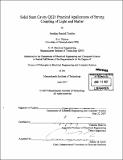Solid state cavity QED : practical applications of strong coupling of light and matter
Author(s)
Tischler, Jonathan Randall, 1977-
DownloadFull printable version (25.49Mb)
Alternative title
Solid state cavity quantum electrodynamics : practical applications of strong coupling of light and matter
Other Contributors
Massachusetts Institute of Technology. Dept. of Electrical Engineering and Computer Science.
Advisor
Vladimir Bulović.
Terms of use
Metadata
Show full item recordAbstract
J-aggregates of cyanine dyes are the excitonic materials of choice for realizing polariton devices that operate in strong coupling at room temperature. Since the earliest days of cavity QED, there has been a major desire to construct solid state optical devices that operate in the limit where strong light-matter interactions dominate the dynamics. Such devices have been successfully constructed, but their operation is usually limited to cryogenic temperatures, because of the small binding energies for the ,excitonic materials typically used. It has been demonstrated that when J-aggregates are used as the excitonic material, it is possible to achieve strong coupling in solid state even at room temperature. J-aggregates are a unique choice of materials because their central feature, a very large optical transitional dipole, is itself the result of strong coupling amongst monomeric dye elements. The strong coupling amongst dye molecules produces a well-defined cooperative optical transition possessing oscillator strength derived from all of the aggregated monomers that is capable of interacting strongly with the cavity confined electromagnetic field even at room temperature. There are different materials and methods for assembling J-aggregates which are capable of producing strong coupling. This thesis argues in favor of a particular dye and method of assembly which are then thoroughly characterized. With this dye and assembly technique, the first demonstration of electrically pumped polariton emission is reported as is the largest optical absorption coefficient for a solid thin film at room temperature not contained in a full microcavity. (cont.) This combination is then used to demonstrate strong coupling at room temperature, as characterized by a light-matter coupling strength, Rabi-splitting, that significantly exceeds the dephasing processes competing against the coherence of the interaction. Finally, prospects of this approach for realizing a polariton laser at room temperature are considered, and improved microcavity architectures are demonstrated as a path towards its realization.
Description
Thesis (Ph. D.)--Massachusetts Institute of Technology, Dept. of Electrical Engineering and Computer Science, 2007. Includes bibliographical references (p. 126-133).
Date issued
2007Department
Massachusetts Institute of Technology. Department of Electrical Engineering and Computer SciencePublisher
Massachusetts Institute of Technology
Keywords
Electrical Engineering and Computer Science.